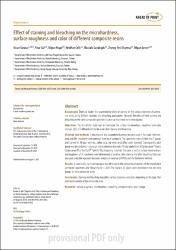| dc.contributor.author | Karataş, Özcan | |
| dc.contributor.author | Gül, Pınar | |
| dc.contributor.author | Akgül, Nilgün | |
| dc.contributor.author | Çelik, Neslihan | |
| dc.contributor.author | Gündoğdu, Mustafa | |
| dc.contributor.author | Duymuş, Zeynep Yeşil | |
| dc.contributor.author | Seven, Nilgün | |
| dc.date.accessioned | 2022-09-08T07:37:07Z | |
| dc.date.available | 2022-09-08T07:37:07Z | |
| dc.date.issued | 2021 | en_US |
| dc.identifier.citation | Karatas, O., Gul, P., Akgul, N., Celik, N., Gundogdu, M., Duymus, Z. Y., & Seven, N. (2021). Effect of staining and bleaching on the microhardness, surface roughness and color of different composite resins. Dental and medical problems, 58(3), 369–376. https://doi.org/10.17219/dmp/131022 | en_US |
| dc.identifier.issn | 1644-387X | |
| dc.identifier.issn | 2300-9020 | |
| dc.identifier.uri | https://doi.org/10.17219/dmp/131022 | |
| dc.identifier.uri | https://hdl.handle.net/11436/6407 | |
| dc.description.abstract | Background. There are studies that examined the effect of staining on the surface properties of composite resins, using different solutions and bleaching applications. However, the effect of both staining and bleaching on the same composite specimens is an issue that needs to be investigated.
Objectives. The aim of this study was to investigate the surface microhardness, roughness and color changes (Delta E) of 2 different composite resins after staining and bleaching.
Material and methods. A microhybrid and a nanohybrid composite were used in the study. One hundred and fifty specimens were prepared from each composite. The specimens were divided into 5 groups and stained for 30 days with tea, coffee, cola, red wine, or distilled water (control). Subsequently, each group was divided into 3 subgroups. Each subgroup received a 14-day application of Opalescence (TM) Boost, Opalescence PF or VivaStyle (R) Paint On Plus bleaching materials. The color as well as surface microhardness and roughness of all specimens were determined at baseline, after staining and after bleaching. Data was analyzed using the repeated-measures analysis of variance (ANOVA) and the Bonferroni method.
Results. A statistically significant decrease was observed in the surface microhardness of the microhybrid composite specimens after bleaching (p < 0.05).The highest Delta E values were observed in the red wine groups for both composite resins.
Conclusions. Staining and bleaching may affect surface properties and color, depending on the type, filler and matrix content of the composite resin. | en_US |
| dc.language.iso | eng | en_US |
| dc.publisher | Weoclaw Medical University | en_US |
| dc.rights | info:eu-repo/semantics/openAccess | en_US |
| dc.subject | Surface roughness | en_US |
| dc.subject | Microhardness | en_US |
| dc.subject | Bleaching | en_US |
| dc.subject | Composite resin | en_US |
| dc.subject | Color change | en_US |
| dc.title | Effect of staining and bleaching on the microhardness, surface roughness and color of different composite resins | en_US |
| dc.type | article | en_US |
| dc.contributor.department | RTEÜ, Diş Hekimliği Fakültesi, Klinik Bilimler Bölümü | en_US |
| dc.contributor.institutionauthor | Duymuş, Zeynep Yeşil | |
| dc.identifier.doi | 10.17219/dmp/131022 | en_US |
| dc.identifier.volume | 58 | en_US |
| dc.identifier.issue | 3 | en_US |
| dc.identifier.startpage | 369 | en_US |
| dc.identifier.endpage | 376 | en_US |
| dc.relation.journal | Dental and Medical Problems | en_US |
| dc.relation.publicationcategory | Makale - Uluslararası Hakemli Dergi - Kurum Öğretim Elemanı | en_US |


















